Optimal Design of a Planar Textile Antenna for Industrial Scientific Medical (ISM) 2.4 GHz Wireless Body Area Networks (WBAN) with the CRO-SL Algorithm
Abstract
1. Introduction
2. Proposed Antenna Design
2.1. Objective Function
3. Methods: The Proposed Coral Reefs Optimization with Substrate Layer
3.1. Basic CRO
- External sexual reproduction or broadcast spawning: The simulation of the broadcast spawning mechanism of a reef is carried out as follows:
- First, we select a random fraction of the existing corals, and they are assigned to be broadcast spawners. The fraction of broadcast spawners with respect to the overall amount of existing corals in the reef will be denoted as .
- Several coral larvae are then formed by applying a given crossover procedure between two broadcast spawners. Note that other exploration strategies can be applied.
- Internal sexual reproduction or brooding: Brooding is another coral reproduction mechanism that is simulated in the algorithm. This reproduction is modeled by means of any kind of mutation technique and takes place on a fraction of corals of . A percentage of the coral is mutated in every step of the algorithm.
- Larvae setting: The larvae formed by the exploration mechanisms described above will try to set and grow in the reef. In this process, each larva randomly tries to settle in a position of the reef, and if the location is free, it will achieve it. If the location is already occupied, the new larva will settle only if its fitness function is better than that of the existing coral. There is a maximum number of tries for a larva to settle down in the reef, , after which the larva will be discarded.
- Asexual reproduction: The CRO can also model asexual reproduction, in the following way: The whole set of corals in the reef are sorted according to their fitness value (given in this case by the objective function described in Section 2). Then, a small fraction (denoted as ) of the available corals is duplicated and mutated (with probability ) to provide variability and to try to settle down again in a different part of the reef as in Step 3.
- Depredation: At the end of each reproduction iteration, a small number of corals in the reef can be depredated, thus liberating space in the reef for the next coral generation (iteration ). The depredation operator is applied with a very small probability () to a fraction () of the corals in the reef with worse health.
3.2. CRO with Substrate Layers
3.3. Substrates Considered in the CRO-SL
- Differential Evolution-based operator (DE): This operator is based on the evolutionary algorithm described in [38]. The DE introduces a differential mechanism for exploring the search space, in such a way that new larvae are generated by perturbing the population members using vector differences of individuals. Perturbations are introduced by applying the rule for each encoded parameter on a random basis, where v corresponds to the output larva, are the considered parents (chosen uniformly among the population) and F determines the evolution factor weighting the perturbation amplitude.
- Harmony Search-based operator (HS): Harmony search [39] is a population-based Metaheuristic (MH) that mimics the improvisation of a music orchestra while it is composing a melody. HS controls how new larvae are generated in one of the following ways: (i) with a probability HMCR (Harmony Memory Considering Rate), the value of a component of the new larva is drawn uniformly from the same values of the component in the other corals; (ii) with a probability PAR (Pitch Adjusting Rate), subtle adjustments are applied to the values of the current larva, replaced with any of its neighboring values.
- Two-point crossover (2PX): 2PX [40] is considered one of the standard recombination operators in evolutionary algorithms. In the standard version of the operator, two parents from the reef population are provided as input. A recombination operation to from two larvae is carried out by randomly choosing two crossover points, interchanging then each part of the corals between those points, as schematically shown in Figure 4.
- Gaussian Mutation (GM): This operator is a variant of the classical random mutation method introducing a scaled Gaussian distribution [41]. Specifically, the Gaussian probability density function is:This operator has a mutation strength value for every parameter of a solution, related to the lower and upper bounds and , respectively. The mutated larva is thus calculated as: , where is a random number following the Gaussian distribution.
- Strange Attractors (SA): SA is a search operator recently proposed in [37] and specifically designed to improve the searching capabilities of MHs by replicating different processes in nature known as fractal geometric patterns, as shown in Figure 5. In particular, it is designed to generate structures of non-linear dynamical systems with chaotic behavior [42]. These kinds of fractal structures can be generated by means of the general two-dimensional quadratic map:In order to introduce a chaotic mutation in a solution using SA, we followed the procedure introduced in [37]. Hence, a determined number of attractors is defined. Each time the operator is applied, a random attractor is considered. The quadratic map is calculated over a random number of iterations starting from an initial condition until x and y are found. Then, the mutated larvae are obtained as:
4. Experiments and Results
4.1. A Note on the CRO-SL Algorithm Performance
5. Conclusions
Author Contributions
Funding
Conflicts of Interest
References
- Campbell, P. Current Population Reports(Population Projections: States. 1995–2025); Census Bureau: Washington, DC, USA, 2005.
- Kwak, K.S.; Sana, U.; Ullah, N. An overview of IEEE 802.15. 6 standard. In Proceedings of the 2010 3rd International Symposium on Applied Sciences in Biomedical and Communication Technologies (ISABEL), Rome, Italy, 7–10 November 2010; pp. 1–6. [Google Scholar] [CrossRef]
- Ullah, S.; Higgins, H.; Braem, B.; Latre, B.; Blondia, C.; Moerman, I.; Saleem, S.; Rahman, Z.; Kwak, K.S. A comprehensive survey of wireless body area networks. J. Med. Syst. 2012, 36, 1065–1094. [Google Scholar] [CrossRef] [PubMed]
- Chen, M.; Gonzalez, S.; Vasilakos, A.; Cao, H.; Leung, V.C. Body area networks: A survey. Mob. Netw. Appl. 2011, 16, 171–193. [Google Scholar] [CrossRef]
- 802.15.6-2012—IEEE Standard for Local and Metropolitan Area Networks—Part 15.6: Wireless Body Area Networks. Available online: https://ieeexplore.ieee.org/document/6161600/versions (accessed on 24 May 2018).
- Guay, P.; Gorgutsa, S.; LaRochelle, S.; Messaddeq, Y. Wearable Contactless Respiration Sensor Based on Multi-Material Fibers Integrated into Textile. Sensors 2017, 17, 1050. [Google Scholar] [CrossRef] [PubMed]
- Azpilicueta, L.; Lopez-Iturri, P.; Aguirre, E.; Mateo, I.; Astrain, J.J.; Villadangos, J.; Falcone, F. Analysis of radio wave propagation for ISM 2.4 GHz wireless sensor networks in inhomogeneous vegetation environments. Sensors 2014, 14, 23650–23672. [Google Scholar] [CrossRef] [PubMed]
- Hertleer, C.; Hendrik, R.; Vallozzi, L.; Van Langenhove, L. A Textile Antenna for Off-Body Communication Integrated Into Protective Clothing for Firefighters. IEEE Trans. Antennas Propag. 2009, 57, 919–925. [Google Scholar] [CrossRef]
- Chen, S.J.; Kaufmann, T.; Fumeaux, C. Wearable textile microstrip patch antenna for multiple ISM band communications. In Proceedings of the Antennas and Propagation Society International Symposium (APSURSI), Orlando, FL, USA, 7–13 July 2013; pp. 1860–1861. [Google Scholar] [CrossRef]
- Klemm, M.; Troester, G. Textile UWB antennas for wireless body area networks. IEEE Trans. Antennas Propag. 2006, 54, 3192–3197. [Google Scholar] [CrossRef]
- Conway, G.A.; Scanlon, W.G. Antennas for over-body-surface communication at 2.45 GHz. IEEE Trans. Antennas Propag. 2009, 57, 844–855. [Google Scholar] [CrossRef]
- El Hajj, W.; Person, C.; Wiart, J. A novel investigation of a broadband integrated inverted-F antenna design; application for wearable antenna. IEEE Trans. Antennas Propag. 2014, 62, 3843–3846. [Google Scholar] [CrossRef]
- Yu, W.; Li, W.; Chang, D.; Li, Y. Small antennas: Miniaturization techniques and applications. Int. J. Antennas Propag. 2014, 2014, 134103. [Google Scholar] [CrossRef]
- Elsheakh, D.M.; Safwat, A.M. Slow-wave quad-band printed inverted-F antenna (IFA). IEEE Trans. Antennas Propag. 2014, 62, 4396–4401. [Google Scholar] [CrossRef]
- Harrison, C.W. Monopole with inductive loading. IEEE Trans. Antennas Propag. 1963, 11, 394–400. [Google Scholar] [CrossRef]
- Hansen, R.C. Efficiency and matching tradeoffs for inductively loaded short antennas. IEEE Trans. Commun. 1975, 23, 430–435. [Google Scholar] [CrossRef]
- Elsheakh, D.; Abdallah, E. Compact multiband multifolded-slot antenna loaded with printed-IFA. IEEE Antennas Wirel. Propag. Lett. 2012, 11, 1478–1481. [Google Scholar] [CrossRef]
- Kehn, M.N.; Quevedo-Teruel, O.; Rajo-Iglesias, E. Reconfigurable loaded planar inverted-F antenna using varactor diodes. IEEE Antennas Wirel. Propag. Lett. 2011, 10, 466–469. [Google Scholar] [CrossRef]
- Khaleghi, A.; Azooulay, A.; Bolomey, J.C. A Dual Band Back Couple Meandering Antenna For Wireless LAN Applications. In Proceedings of the 2005 IEEE 61st Vehicular Technology Conference, Stockholm, Sweden, 30 May–1 June 2005. [Google Scholar]
- Wong, K.L. Planar antennas for Wireless Communication; John Wiley and Sons: New York, NY, USA, 2003. [Google Scholar]
- Warnagiris, T.; Minardo, T. Performance of a meander line as an electric ally small transmitting antenna. IEEE Trans. Antennas Propag. 1998, 46, 1797–1801. [Google Scholar] [CrossRef]
- Sánchez-Montero, R.; Salcedo-Sanz, S.; Portilla-Figueras, J.A.; Langley, R. Hybrid PIFA-patch antenna optimized by evolutionary programming. Progress In Electromagn. Res. 2010, 108, 221–234. [Google Scholar] [CrossRef]
- Sánchez-Montero, R.; López-Espi, P.L.; Cruz-Rodriguez, A.C.; Rigelsford, J.M. Multiple band antenna optimization using heuristics and bio-inspired optimization algorithms. In Proceedings of the 2012 IEEE Antennas and Propagation Conference (LAPC), Loughborough, UK, 12–13 November 2012; pp. 1–4. [Google Scholar] [CrossRef]
- López-Ruiz, S.; Sánchez-Montero, R.; Tercero-Martínez, F.; López-Espí, P.L.; López-Fernández, J.A. Optimization of a conical corrugated antenna using multiobjective heuristics for radio-astronomy applications. Int. J. Antennas Propag. 2016, 2016, 7024704. [Google Scholar] [CrossRef]
- Salcedo-Sanz, S.; Camacho-Gómez, C.; Molina, D.; Herrera, F. A Coral Reefs Optimization algorithm with substrate layers and local search for large scale global optimization. In Proceedings of the 2016 IEEE World Congress on Computational Intelligence, Vancouver, BC, Canada, 24–29 July 2016. [Google Scholar] [CrossRef]
- Salcedo-Sanz, S.; del Ser, J.; Landa-Torres, I.; Gil-López, S.; Portilla-Figueras, A. The Coral Reefs Optimization algorithm: A novel metaheuristic for efficiently solving optimization problems. Sci. World J. 2014, 2014, 739768. [Google Scholar] [CrossRef] [PubMed]
- Salcedo-Sanz, S.; Pastor-Sánchez, A.; Blanco-Aguilera, A.; Prieto, L.; García-Herrera, R. Feature selection in wind speed prediction systems based on a hybrid Coral Reefs Optimization—Extreme Learning Machine approach. Energy Convers. Manag. 2014, 87, 10–18. [Google Scholar] [CrossRef]
- Salcedo-Sanz, S.; Camacho-Gómez, C.; Magdaleno, A.; Pereira, E.; Lorenzana, A. Structures vibration control via tuned mass dampers using a co-evolution coral reefs optimization algorithm. J. Sound Vib. 2017, 393, 62–75. [Google Scholar] [CrossRef]
- Salcedo-Sanz, S.; Camacho-Gómez, C.; Mallol-Poyato, R.; Jiménez-Fernández, S.; del Ser, J. A novel Coral Reefs Optimization algorithm with substrate layers for optimal battery scheduling optimization in micro-grids. Soft Comput. 2016, 20, 4287–4300. [Google Scholar] [CrossRef]
- Design Note DNO023. Available online: http://www.ti.com/lit/an/swra228c/swra228c.pdf (accessed on 15 May 2018).
- Lee, H.; Tak, J.; Choi, J. Wearable Antenna Integrated into Military Berets for Indoor/Outdoor Positioning System. IEEE Antennas Wirel. Propag. Lett. 2017, 16, 1919–1922. [Google Scholar] [CrossRef]
- Khaleel, H. Innovation in Wearable and Flexible Antennas; Wit Press: Southampton, UK, 2014; ISBN 978-1-84564-9. [Google Scholar]
- CST MICROWAVE STUDIO. Available online: https://www.cst.com/products/CSTMWS (accessed on 15 May 2018).
- Vermeij, M.J. Substrate composition and adult distribution determine recruitment patterns in a Caribbean brooding coral. Mar. Ecol. Prog. Ser. 2005, 295, 123–133. [Google Scholar] [CrossRef]
- Salcedo-Sanz, S.; Muñoz-Bulnes, J.; Vermeij, M. New coral reefs-based approaches for the model type selection problem: a novel method to predict a nation’s future energy demand. Int. J. Bio-Inspir. Comput. 2017, 10, 145–158. [Google Scholar] [CrossRef]
- Camacho-Gómez, C.; Wang, X.; Díaz, I.; Pereira, E.; Salcedo-Sanz, S. Active vibration control design using the Coral Reefs Optimization with Substrate Layer algorithm. Comput. Struct. 2017, 157, 14–26. [Google Scholar] [CrossRef]
- Salcedo-Sanz, S. Modern metaheuristics based on nonlinear physics processes: A review of models and design procedures. Phys. Rep. 2016, 655, 1–70. [Google Scholar] [CrossRef]
- Storn, R.; Kenneth, P. Differential Evolution—A simple and efficient heuristic for global optimization over continuous spaces. J. Glob. Optim. 1997, 11, 341–359. [Google Scholar] [CrossRef]
- Geem, Z.W.; Kim, J.H.; Loganathan, G.V. A new heuristic optimization algorithm: Harmony Search. Simulation 2001, 76, 60–68. [Google Scholar] [CrossRef]
- Eiben, A.E.; Smith, J.E. Introduction to Evolutionary Computing; Springer: Berlin/Heidelberg, Germany, 2003; ISBN 3-540-40184-9. [Google Scholar]
- Bäck, T.; Schwefel, H.P. An overview of Evolutionary Algorithms for parameter optimization. Evol. Comput. 1993, 1, 1–23. [Google Scholar] [CrossRef]
- Grassberger, P.; Procaccia, I. Characterization of strange attractors. Phys. Rev. Lett. 1983, 50, 346–349. [Google Scholar] [CrossRef]
- Specifications of WLAN Directive Wearable Antenna. Available online: http://www.pharad.com/wlan-directive-wearable-antenna.html (accessed on 15 June 2018).
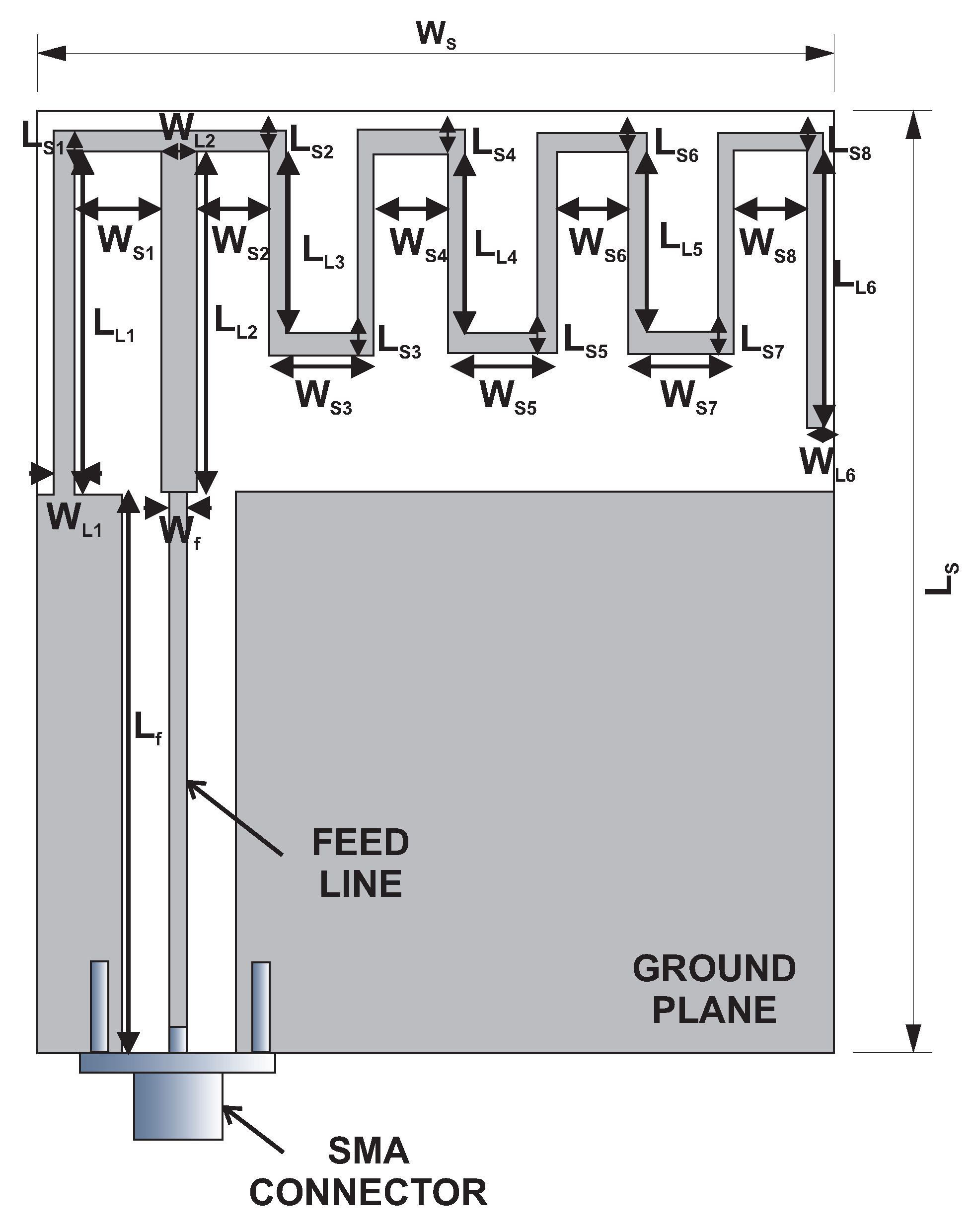
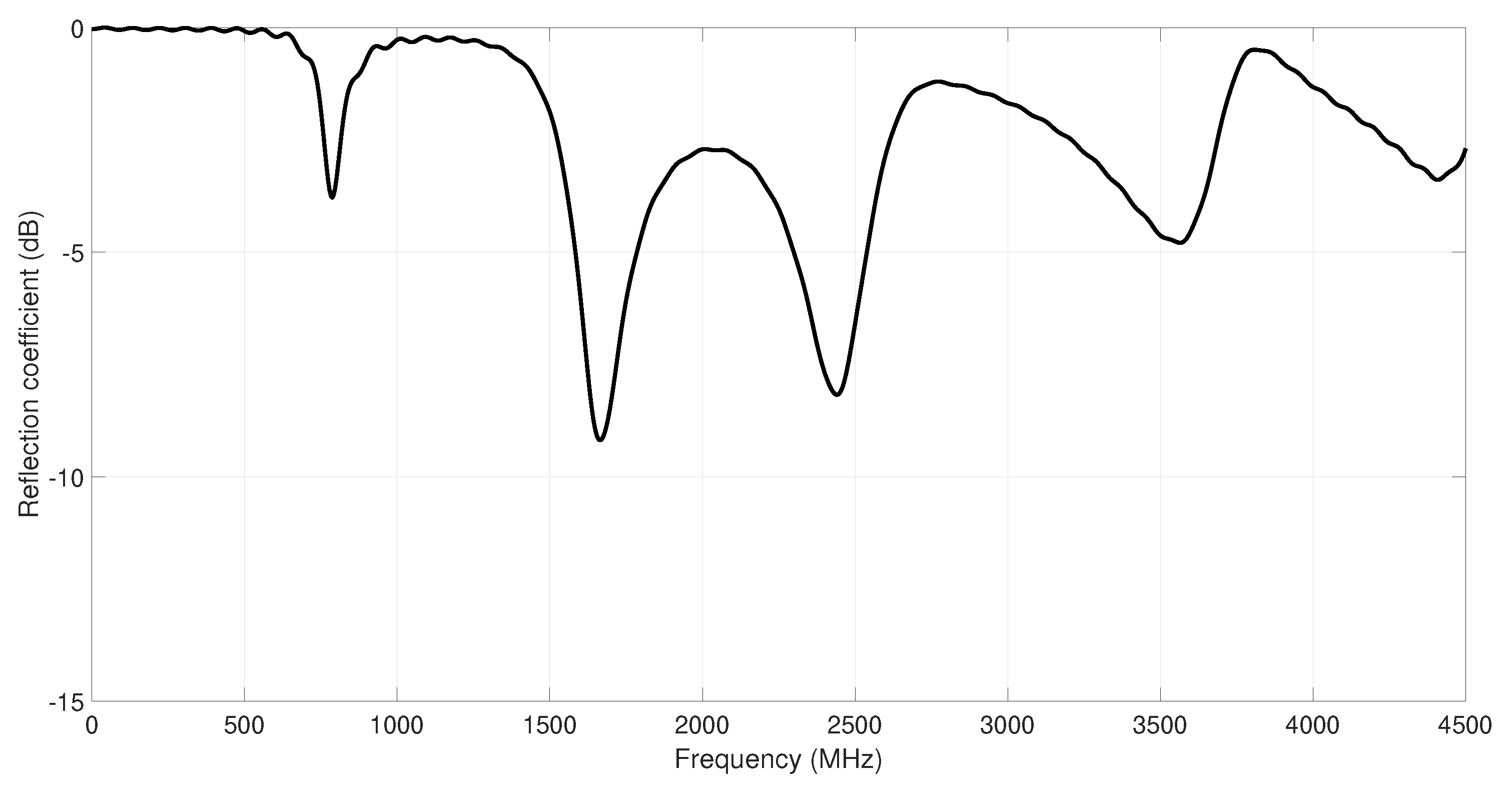
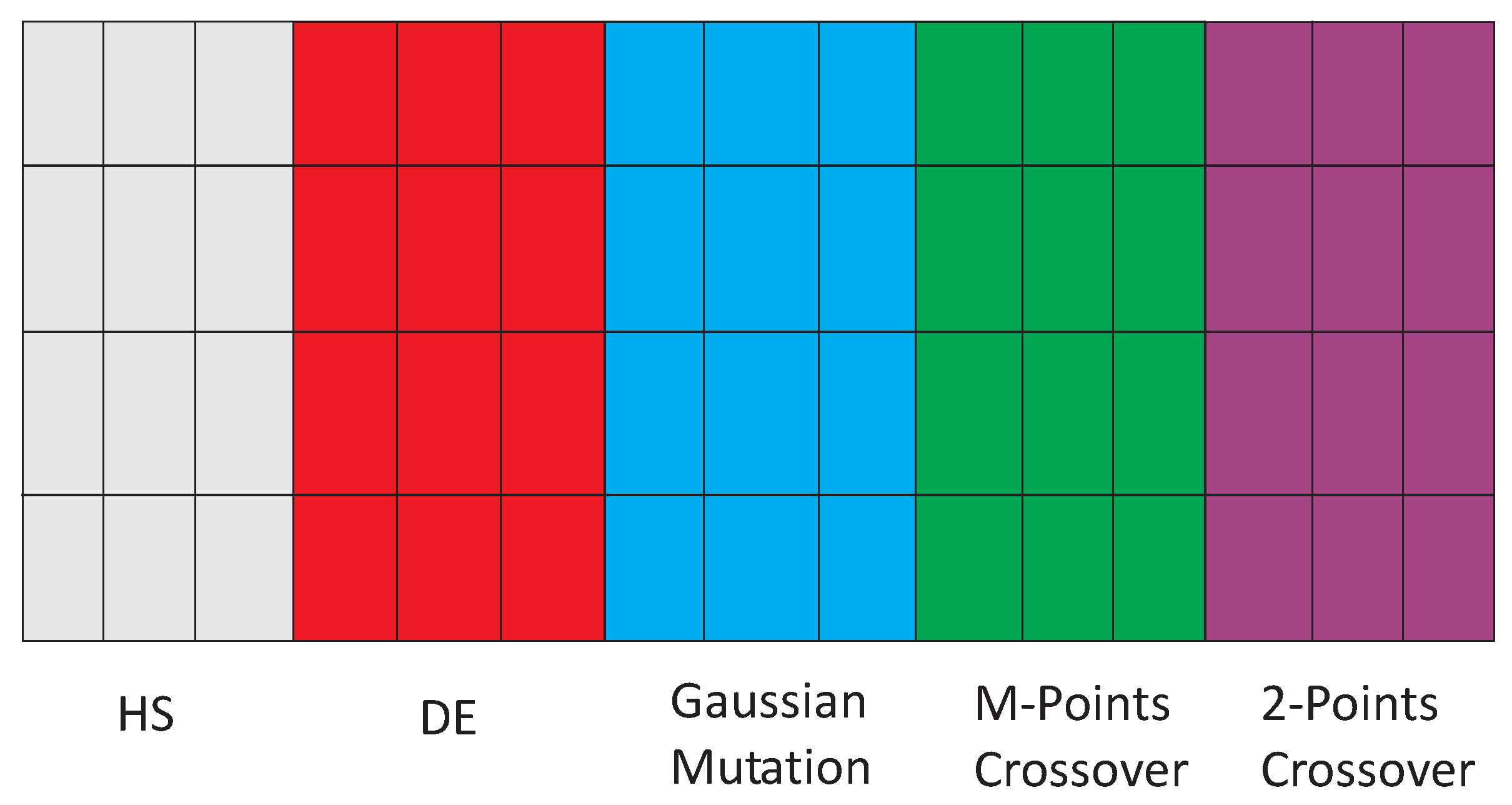




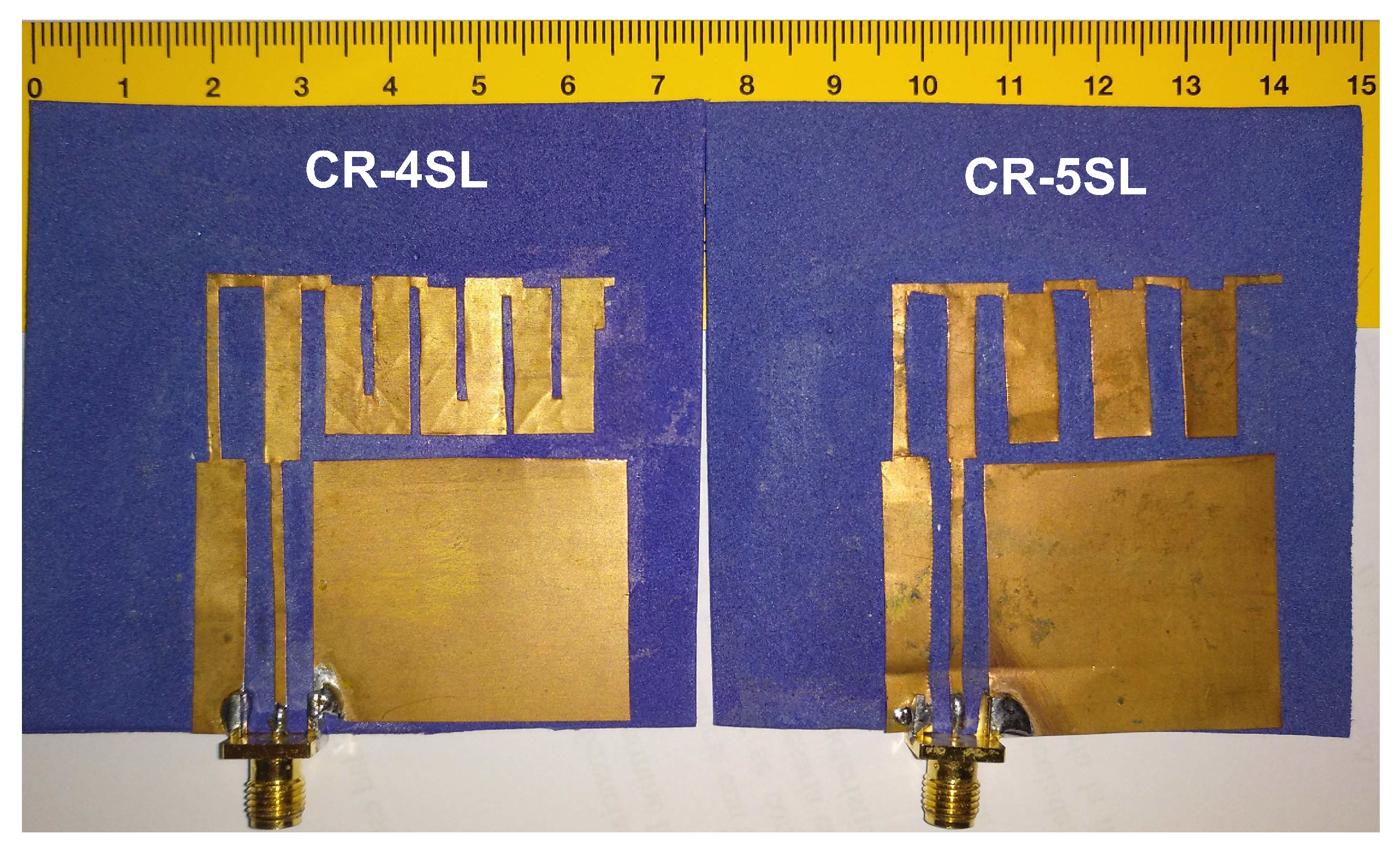


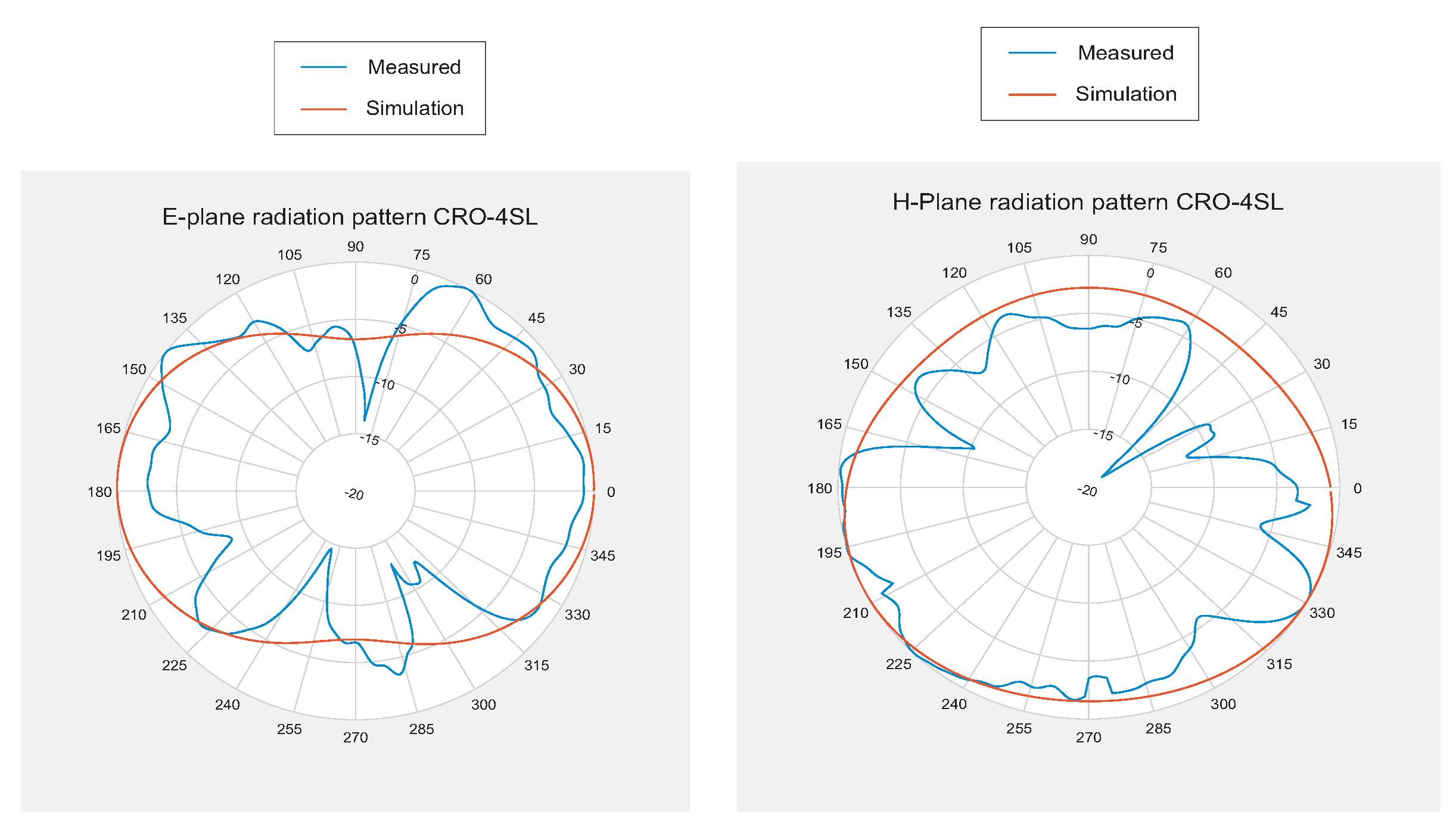
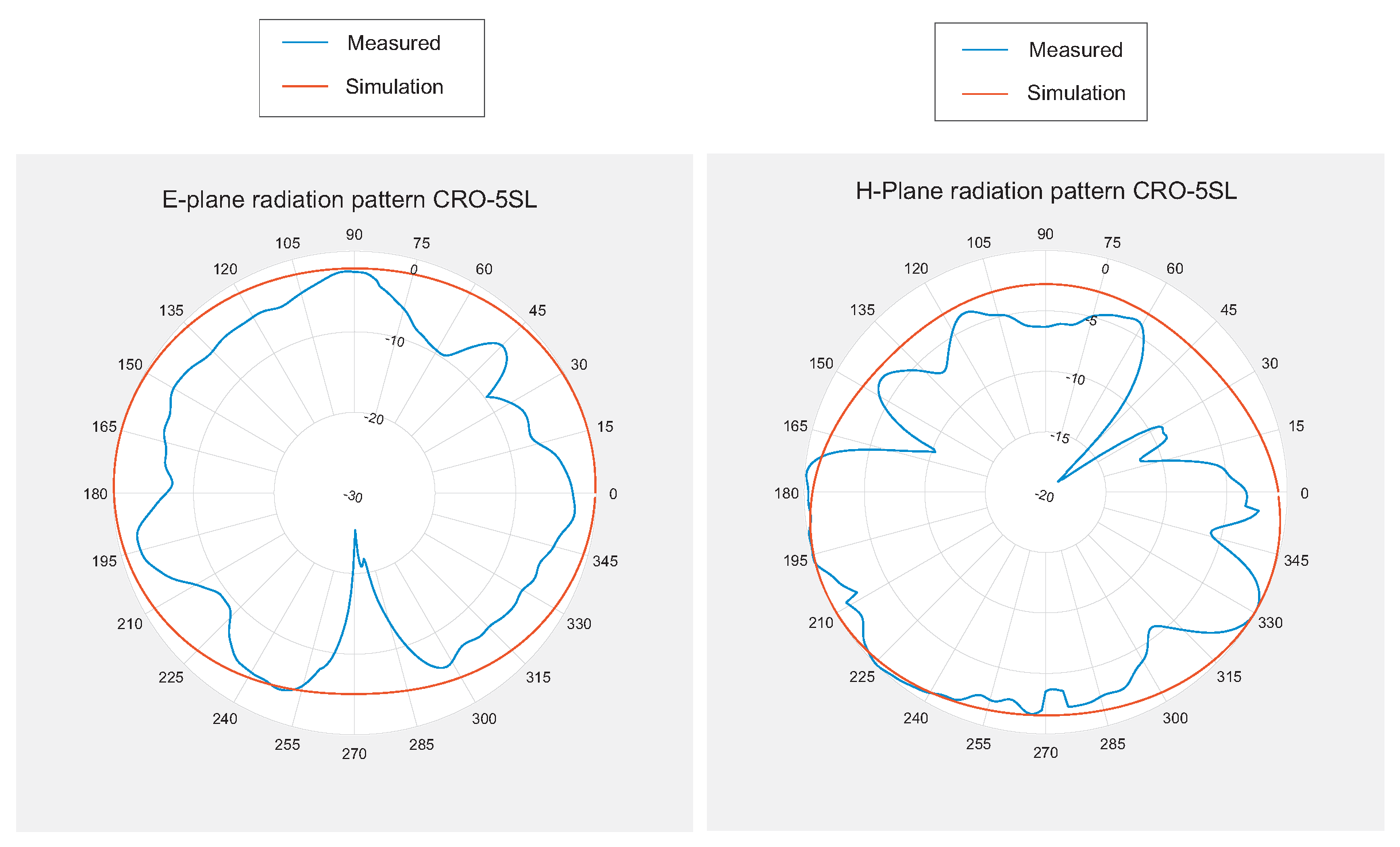

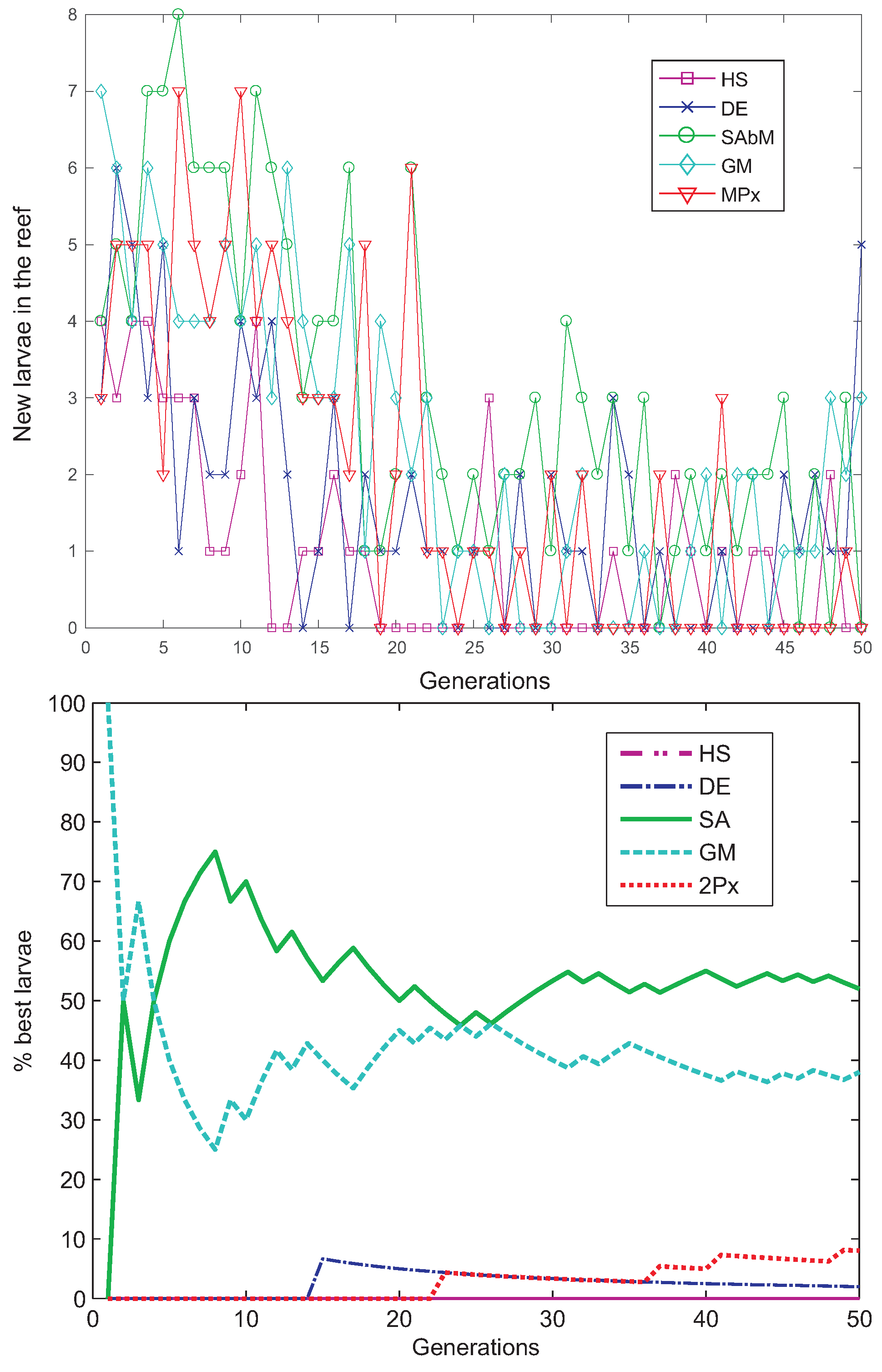
| Variable | Value (mm) | Variable | Value (mm) |
|---|---|---|---|
| 52 | 44.5 | ||
| 31 | 1 | ||
| 19 | 1 | ||
| 19 | 2 | ||
| 10.25 | 1 | ||
| 10.25 | 1 | ||
| 10.25 | 1 | ||
| 15 | 1 | ||
| 1 | 5 | ||
| 1 | 4 | ||
| 1 | 6 | ||
| 1 | 4 | ||
| 1 | 6 | ||
| 1 | 4 | ||
| 1 | 6 | ||
| 1 | 4 |
| Phase | Parameter |
|---|---|
| Initialization | Reef size = |
| External sexual reproduction | |
| substrates: HS, DE, 2PX, GM, SA | |
| Internal sexual reproduction | |
| Larvae setting | |
| Asexual reproduction | |
| Depredation | |
| Stop criterion | iterations. |
| Variable (mm) | Original | CRO-4SL | CRO-5SL |
|---|---|---|---|
| 52 | 52 | 52 | |
| 44.5 | 44.5 | 44.5 | |
| 31 | 31.01 | 29.76 | |
| 1 | 1 | 1 | |
| 19 | 18.93 | 19.67 | |
| 1 | 1 | 1.10 | |
| 19 | 19.74 | 20.66 | |
| 2 | 2.97 | 3.47 | |
| 10.25 | 17.5 | 13.06 | |
| 1 | 1 | 5 | |
| 10.25 | 17.5 | 13.06 | |
| 1 | 1 | 4 | |
| 10.25 | 17.5 | 13.06 | |
| 1 | 1 | 4 | |
| 15 | 0 | 5.96 | |
| 1 | 1 | 1.73 | |
| 1 | 0.81 | 0.87 | |
| 5 | 5 | 5 | |
| 1 | 1.19 | 1.13 | |
| 4 | 5 | 5 | |
| 1 | 17.5 | 0 | |
| 6 | 6 | 0 | |
| 1 | 1.19 | 1 | |
| 4 | 6 | 6 | |
| 1 | 17.5 | 1.13 | |
| 6 | 6 | 6 | |
| 1 | 1.19 | 1.13 | |
| 4 | 6 | 6 | |
| 1 | 17.5 | 0 | |
| 6 | 6 | 0 | |
| 1 | 0.99 | 1.13 | |
| 4 | 5 | 0 |
| Algorithm | Best Fitness |
|---|---|
| CRO-5SL | 39.9009 |
| HS | 9.4808 |
| GA (2PX crossover) | 9.4376 |
| ES (GM) | 11.0827 |
| DE | 9.8170 |
© 2018 by the authors. Licensee MDPI, Basel, Switzerland. This article is an open access article distributed under the terms and conditions of the Creative Commons Attribution (CC BY) license (http://creativecommons.org/licenses/by/4.0/).
Share and Cite
Sánchez-Montero, R.; Camacho-Gómez, C.; López-Espí, P.-L.; Salcedo-Sanz, S. Optimal Design of a Planar Textile Antenna for Industrial Scientific Medical (ISM) 2.4 GHz Wireless Body Area Networks (WBAN) with the CRO-SL Algorithm. Sensors 2018, 18, 1982. https://doi.org/10.3390/s18071982
Sánchez-Montero R, Camacho-Gómez C, López-Espí P-L, Salcedo-Sanz S. Optimal Design of a Planar Textile Antenna for Industrial Scientific Medical (ISM) 2.4 GHz Wireless Body Area Networks (WBAN) with the CRO-SL Algorithm. Sensors. 2018; 18(7):1982. https://doi.org/10.3390/s18071982
Chicago/Turabian StyleSánchez-Montero, Rocío, Carlos Camacho-Gómez, Pablo-Luís López-Espí, and Sancho Salcedo-Sanz. 2018. "Optimal Design of a Planar Textile Antenna for Industrial Scientific Medical (ISM) 2.4 GHz Wireless Body Area Networks (WBAN) with the CRO-SL Algorithm" Sensors 18, no. 7: 1982. https://doi.org/10.3390/s18071982
APA StyleSánchez-Montero, R., Camacho-Gómez, C., López-Espí, P.-L., & Salcedo-Sanz, S. (2018). Optimal Design of a Planar Textile Antenna for Industrial Scientific Medical (ISM) 2.4 GHz Wireless Body Area Networks (WBAN) with the CRO-SL Algorithm. Sensors, 18(7), 1982. https://doi.org/10.3390/s18071982






